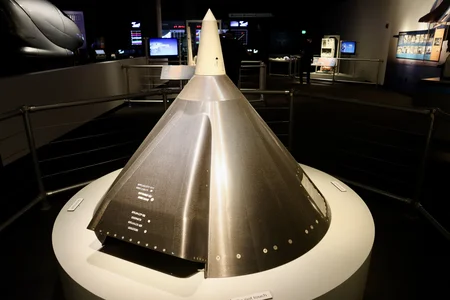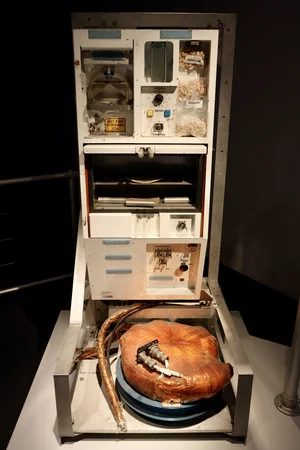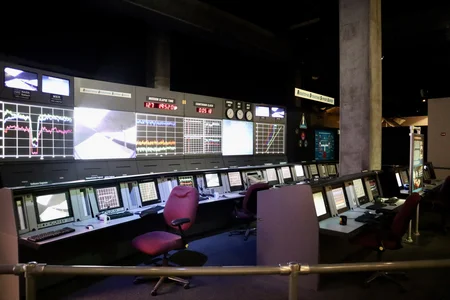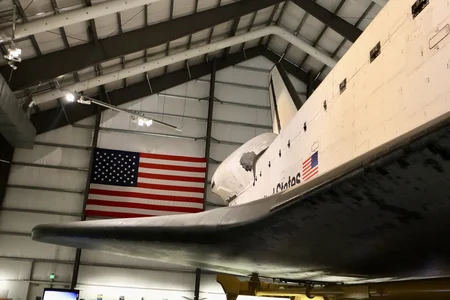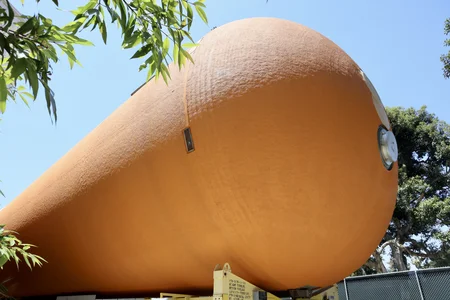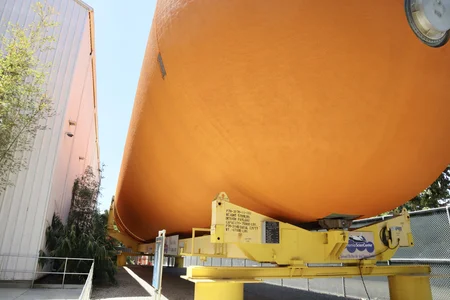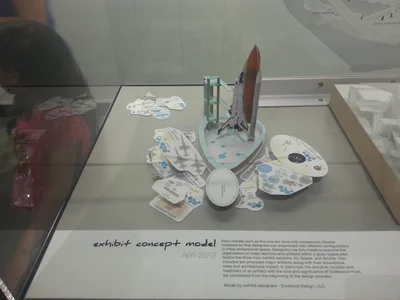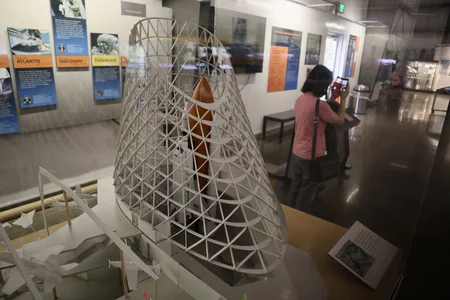The California Science Center is a state museum located in Exposition Park, Los Angeles.
Visited 31 December 2013 and 5 June 2022.
Roy A. Anderson Blackbird Exhibit and Garden
- Lockheed A-12 "Titanium Goose"
-
This A-12, serial number 60-6927, is the sole two-seat trainer built. Because this aircraft was developed for the Central Intelligence Agency, the "A-12" designation is not in any way connected to the tri-service aircraft designation system; instead, it is an in-house Lockheed name and number referring to the twelth design iteration of black project "Archangel". The CIA randomly assigned the codename "Oxcart" for the development and operation of this aircraft, but the flight crews unofficially named the aircraft "Cygnus".
A total of fifteen A-12s were built: twelve "regular" A-12s, one two-seat trainer variant, and two M-21 drone carrier variants; six were lost in action.
-

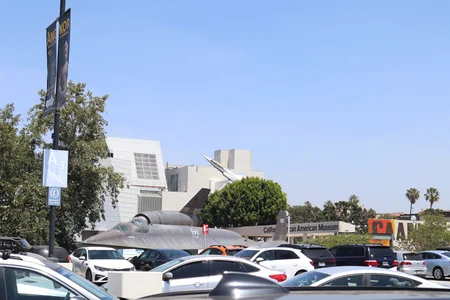


Howard F. Ahmanson Building
- Northrop T-38A Talon
- This T-38A, serial number 58-1196, was built in 1959 as the third of the four pre-production YT-38s. It was loaned to the California Science Center in 1990.
-
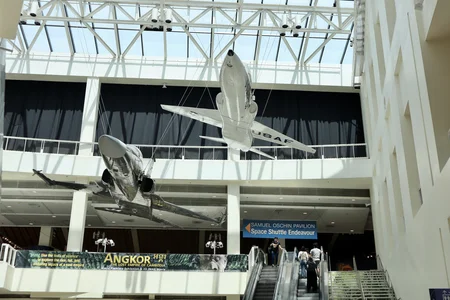

- Northrop F-20 Tigershark
- This F-20, serial number 82-0063 and civil registration N3986B, is the sole surviving example out of three prototypes built.
-


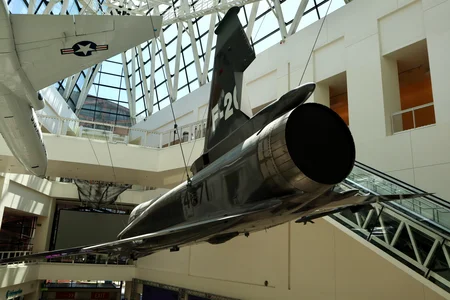


Aquarium
Air & Space Exhibits
- Mercury-Redstone 2
- Mercury-Redstone 2 was the second mission of Project Mercury, in which Mercury No. 5 was tested with the chimpanzee "Ham". The Mercury spacecraft launched on a Mercury-Redstone launch vehicle on 31 January 1961 for a 16 minute, 39 second suborbital flight.
-




- Gemini 11
-
Gemini 11 was the ninth crewed mission of Project Gemini, in which Gemini SC11 made a direct-ascent rendezvous with unmanned Gemini-Agena Target Vehicle 5006 (GATV). The Gemini spacecraft launched on a Titan II GLV launch vehicle on 12 September 1966 and carried astronauts Pete Conrad and Richard Gordon. It then returned to Earth on 15 September 1966.
-




- Apollo-Soyuz Test Project
-
The Apollo-Soyuz Test Project was the first international space mission in history, in which Apollo CSM-111 and Soyuz 7K-TM No. 75 rendezvoused and docked with each other in low earth orbit. The officially unnumbered Apollo mission launched on a Saturn IB launch vehicle on 15 July 1975 and carried astronauts Thomas P. Stafford, Vance D. Brand, and Deke Slayton, while Soyuz 19 launched on a Soyuz-U launch vehicle on 15 July 1975 and carried cosmonauts Alexei Leonov and Valeri Kubasov. The Apollo returned to Earth on 24 July 1975 and Soyuz 19 returned to Earth on 21 July 1975.
-


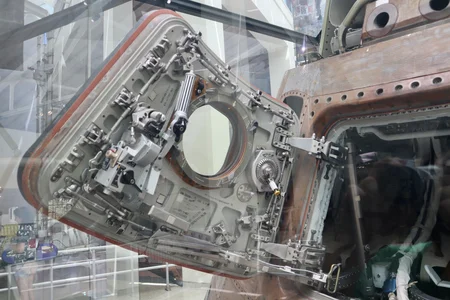

Endeavour Together: Parts & People
Rocketdyne Operations Support Center
The Rocketdyne Operations Support Center was located at the company headquarters in Canoga Park and provided real-time telemetry monitoring and technical support for the operation of the Space Shuttle Main Engines during every single Shuttle mission and ground test fire. The exhibit here is the entire actual ROSC, which was decommissioned at the end of the Shuttle program.
Mission 26: The Big Endeavour
The "Mission 26" exhibit chronicles the final journey of Endeavour back home to her birthplace in Southern California with this stunning time-lapse documentary film directed by Haley Jackson:
Since the exhibit was designed for the general public and didn't emphasize the technical aspects of Endeavour's trip, I have taken it as a starting point for my own research project on the orbiter deliveries.
Samuel Oschin Pavilion
The Samuel Oschin Pavilion was the temporary home of the Space Shuttle orbiter Endeavour from her arrival in Southern California until 31 December 2023.
Space Shuttle Orbiter Endeavour
Endeavour (OV-105) is the last of the five spaceworthy orbiters constructed for the Space Shuttle program. She was built from 1987 to 1992 as a replacement for the destroyed Challenger, and introduced a large number of technical upgrades which were later backfitted to her sister shuttles.
- Space Shuttle Aerodynamic Control Surfaces
- The orbiter's aerodynamic control surfaces consist of an elevon at the trailing edge of each wing, a body flap at the rear of the main fuselage, and a rudder at the trailing edge of the vertical stabilizer. The rudder is split so that it can be simultaneously opened on both sides to act as a speed brake.
-


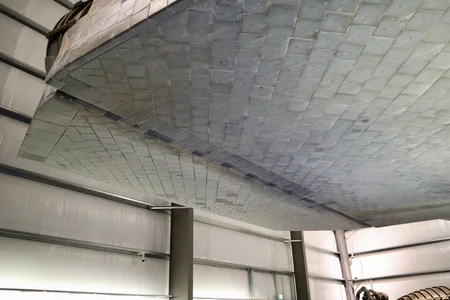
- Space Shuttle Main Engines
- The Space Shuttle's primary propulsion is provided by a set of three gimbal mounted Rocketdyne RS-25 liquid fuel rockets, also known as Space Shuttle Main Engines. These engines burn cryogenic liquid hydrogen fuel and liquid oxygen oxidizer, with each engine having a vacuum thrust rating of 2.279 meganewtons and a specific impulse of 452.3 seconds.
-



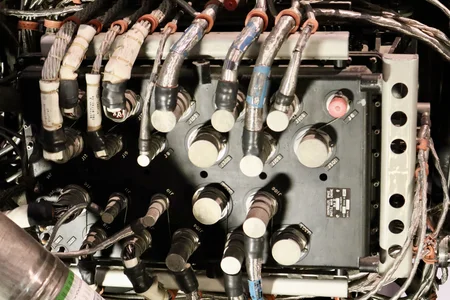
- Space Shuttle Orbital Maneuvering System
-
The Space Shuttle's orbital maneuvering system (OMS) is used to perform orbital injection, orbital correction, and deorbit burns. It consists of two Rocketdyne AJ10-190 liquid fuel rockets mounted in large pods located on the upper sides of the orbiter aft fuselage, flanking the vertical tail. These engines burn monomethylhydrazine (MMH) fuel and nitrogen tetroxide oxidizer, with each engine having a vacuum thrust of 26.7 kilonewtons (6,000 lbf) and a specific impulse of 316 seconds.
All Shuttle orbiters were built with provisions to mount up to three "OMS Payload Bay Kit" palletized add-on fuel modules at the aft end of the cargo bay, utilizing the same fuel and oxidizer tanks as the OMS pods to add approximately 150 m⁄s of maneuvering Delta-V per module. However, none of these modules were ever built or flown.
Other versions of the Rocketdyne AJ10 engine were also used for the "Able" second stage of the Vanguard launch vehicle, the "Transtage" second stage of the Titan III launch vehicle, the "Delta-F" upper stage of the Delta 1000 launch vehicle, the "Delta-K" upper stage of the Delta II launch vehicle, and the Apollo Service Module Propulsion System.
- Space Shuttle Reaction Control System
- The Space Shuttle's reaction control system (RCS) is used to provide attitude control and translation while in outer space. The forward RCS module is located in the orbiter's nose and contains fourteen primary and two vernier thrusters; the two aft RCS modules are located in the OMS pods and contain twelve primary and two vernier thrusters each. All of the RCS thrusters burn monomethylhydrazine (MMH) fuel and nitrogen tetroxide oxidizer.
-

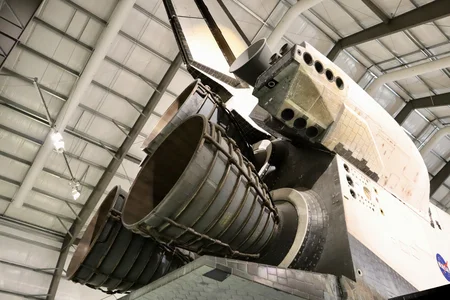

- Umbilical Doors
- One of the benefits of Endeavour's temporary display is that the umbilical connections on the bottom of the orbiter are exposed. The port and starboard umbilical assemblies are dual-redundant, each having a full set of fluid and electrical interfaces.
-



- Seismic Isolators
- Endeavour is still mounted on the Overland Transporter strongback frame, bolted dowwn on sliding seismic isolators designed by Earthquake Protection Systems.
-




Shuttle External Tank ET-94
Located directly outside the pavilion is ET-94, the last flight-qualified shuttle external tank remaining from the shuttle program. ET-94 was one of three "deferred build" lightweight tanks which were ordered specifically for the Space Shuttle Columbia after the introduction of super-lightweight tanks. These tanks were intended to be used on low-earth orbit science missions where the super-lightweight tanks offered no practical advantage; such missions were always carried out by Columbia because she was heavier than the other Shuttles and did not have a Space Station docking system permanently taking up part of her cargo bay.
Columbia used tank ET-93 on her fatal STS-107 mission, and the completed ET-94 was extensively examined as part of the accident investigation. Construction of ET-95 was cancelled and super-lightweight tanks were used for all subsequent Shuttle flights, leaving ET-94 as the only unused fight-qualified tank.
- Sources
- Ray, Justin. (21 May 2016). Parade moves last shuttle fuel tank to museum for Endeavour display. Spaceflight Now.
Shuttle Solid Rocket Boosters
Stored offsite at the Mojave Spaceport are a pair of Shuttle Solid Rocket Boosters which were donated by Orbital ATK in 2017. Because the reusable SRB segments are modular and were recombined between missions, these exact boosters have never flown as a combined set; however, the segments chosen for the display boosters are all authentic components which flew on 81 different Shuttle launches, including Columbia's first operational mission (STS-5), the maiden launches of Challenger (STS-6), Atlantis (STS-51-J), and Endeavor (STS-49), and Discovery's final mission (STS-133). All of the non-motor components (forward and aft domes, aft stiffeners, external tank attach rings) are also flight components.
- Source
- Ray, Justin. (28 March 2017). Twin solid rockets, reused veterans of spaceflight, set for Endeavour display. Spaceflight Now.
- Evans, Ben. (20 September 2020). Northrop Grumman Donates Flight-Proven SRBs to Endeavour Exhibit at CSC. AmericaSpace.
California Science Center Phase III Expansion
Phase III of the Science Center's expansion plan centers on the new Samuel Oschin Air and Space Center. This 200,000 square foot building will house the CSC's expanded aerospace collection, with Endeavour as its centerpiece exhibit. Construction of this building was originally planned for 2016-2018, but was delayed by funding shortfalls and the COVID-19 epidemic to actually begin on 1 June 2022.
Go For Payload
Go For Payload was carried out from 6 October 2014 to 21 October 2014.
"Go for Payload" was the loading of Endeavour's payload bay with a simulated cargo load for her future permanent display. This payload is based on the flight configuration of mission STS-118, including an authentic SPACEHAB module, authentic Integrated Cargo Carrier a replica External Airlock and Orbiter Docking System, a replica Tunnel Adapter, a replica Shuttle Remote Manipulator System, and four replica payload bay cameras.
The SPACEHAB module installed in the payload bay is one of a pair of modules which were originally connected to each other to form the SPACEHAB Logistics Double Module. It has been modified with a replacement bulkhead on one side to convert it into a single module configuration. Somewhat ironically, the Science Center does in fact possess the actual SPACEHAB Logistics Single Module from STS-118, but has opted to keep this as a seperate display.
- Sources
- California Science Center. (6 October 2014). Go for Payload Delicate Operation Underway for Endeavour.
- CollectSpace. (9 October 2014). Go for Payload! Spacehab installed in shuttle Endeavour for display.
- SpaceflightNow. (10 October 2014). Endeavour Reunited with Spacehab Payload In Museum.
- CollectSpace. (21 October 2014). Space shuttle doors shut after cargo loaded for launch-like display.
- NASA. SPACEHAB Logistics Double Module
Go For Stack
Go For Stack began on 20 July 2023 and was completed on 30 January 2024.
"Go For Stack" is a modified version of NASA's launch assembly process which will occcur over a period of approximately six months in order to configure the Endeavor orbiter, ET-94 external tank, and two solid rocket boosters into a vertical display.
20 July 2023
On this date, the Solid Rocket Booster aft skirts were installed on seismimc isolator pads integrated into the floor of the new building (still under construction). These skirts not only support the weight of the entire STS stack, but also hold it down against the thrust of all three Shuttle Main Engines. This is accomplished by 28 inch long, 3.5 inch in diameter hold-down bolts attached to four hold-down posts on the outside of the skirts.
The aft skirts in the display stack flew on a combined total of 15 STS launches, with the first one being with Columbia on STS-3 and the last one being with Endeavour on STS-130.
11 October 2023
On this date, the two complete Solid Rocket Booster assemblies were transported from their storage location at the Mojave Spaceport to the Science Center via flatbed truck. They were then installed on top of the aft skirts.
11 January 2024
On this date, the ET-94 external tank was moved from its temporary holding area adjacent to the Oschin Pavilion and mated to the SRB assemblies.
30 January 2024
On this date, the Endeavour orbiter was moved from the Oschin Pavilion, lifted vertical, and mated to the external tank.
- Sources
- CollectSpace. (12 December 2016). Shuttling space artifacts: booster parts bound for Endeavour exhibit.
- California Science Center. Go For Stack: Endeavour's Final Move.


